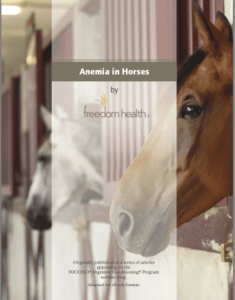Anemia in horses is rarely discussed outside of racing circles, but is an insidious condition with significant impact on a horse’s health and performance ability. In this five part series, we will provide a comprehensive look at equine anemia: what anemia is and how it affects horses, what causes equine anemia, signs and symptoms, ulcers and anemia, and treatments. Subscribe to the SUCCEED blog to follow the complete series.
Anemia, a reduction in red blood cell mass, has the potential to significantly impact a horse’s health and performance. In addition to the fact that it signals a more serious health problem, it can mean the difference in the hundredths of a second between first and second, the animation to score an 8 instead of a 7 on that movement, the impulsion to clear that highest rail.
While the symptoms of anemia in horses include a few clear health signals, it always needs to be diagnosed by a veterinarian through a blood test. There are two important concepts to keep in mind when considering whether or not your horse’s symptoms point to anemia:
1. The symptoms of equine anemia can also signal a host of other health problems
2. Anemia itself IS a symptom of an underlying, potentially serious, disease
Be sure to revisit
Part 1: What is Anemia in Horses and
Part 2: Causes of Anemia in Horses to learn about what anemia is, how it is identified, how it impacts your horse’s health and performance, and the three types of health issues that cause it.
Here’s a look at the direct, measurable impact anemia has on your horse’s health and the importance of looking at anemia as a symptom itself.
Clinical Health Symptoms of Anemia in Horses
There are three clinical symptoms that anemic horses typically display:
- Pale mucous membranes. Check the membranes around your horse’s eyes and nose and its gums for a healthy pink color. Pale-colored membranes indicate something is wrong in your horse’s body, and it could be anemia.
- Increased heart rate. A reduction in red blood cells means that the horse’s heart has to work harder to pump oxygenated blood around the body.
- Lethargy. A horse that is anemic is going to be lackluster and low on energy. Red blood cells are responsible for delivering oxygen throughout the body. Too little oxygen affects the muscles as well as metabolism, which is responsible for turning food into energy.
Poor hair coat and loss of appetite may also result when a horse is anemic. While these three symptoms described above are classic signs of anemia, they can also signal a variety of other conditions as well. Fortunately, it’s relatively simple for your vet to run blood tests to find out whether anemia may be causing the pale mucous membranes, lethargy, or loss of appetite – or if it’s something else entirely.
Blood Tests that Indicate a Horse is Anemic
There are several types of blood tests your veterinarian can run to determine if your horse may be considered anemic. Anemia is a reduction in red blood cell mass that can be detected through a number of measures, including packed cell volume, red blood cell count or hemoglobin concentration. Let’s look at each of these:
Packed Cell Volume
Packed Cell Volume (PCV), also known as a hematocrit, measures the percentage of red blood cells in blood and is the most common test for anemia. A blood sample is placed in a centrifuge and separated into its three parts: red blood cells, plasma and buffy coat (essentially the layer between blood cells and plasma that contains most of the white blood cells and platelets). A normal red blood cell range for horses on a PCV is between 32-48%. Lower than 30% may indicate anemia.
A PCV is generally run as part of a standard Complete Blood Count (CBC).
Red Blood Cell Count
The red blood cell count (RBC) is a measure of the number of circulating red blood cells in a given volume It is typically expressed as millions of cells per microliter. A normal RBC count in horses ranges between 6.5-11.9.
Hemoglobin Concentration
Measuring the concentration of hemoglobin in a horse’s blood is a test that is used only when hemolytic (blood destruction) anemia is suspected. Hemoglobin is a protein within red blood cells that is responsible for carrying oxygen. It can be measured in a laboratory using an instrument called a hemoglobinometer. It is measured in grams/deciliter (or g/dl). The normal range for hemoglobin concentration in red blood cells for horses is 8-19 g/dl.
Interpreting Test Results
It’s important to keep in mind that interpreting the results of one of these blood tests is subjective. The normal ranges used for each test are not set in stone; they simply express what is typical for most horses. Your veterinarian will use this information in tandem with other diagnostic testing, history, examination, and more, to determine if the results are indicative of anemia.
Also, it’s important to keep in mind that “hot-blooded” and performance horses tend to naturally have a higher red blood cell mass than say a draft breed or leisure horse. As a result, a PCV around 30% may be normal for one horse, but could potentially indicate low-grade anemia in a performance horse.
Finally, horses store up to 30% of their red blood cells in the spleen. This highly oxygenated blood is then released any time the horse goes into “flight mode.” Therefore, a horse just back from a hard work, galloping in from the pasture, or recovering from a spook will have an artificially high red blood cell mass on these tests. Therefore, it’s important to be very careful about when you test and to perhaps test your horse’s blood at several different times.
Anemia in Horses is a Symptom of Disease
While the symptoms discussed above are ways for you and a veterinarian to identify that a horse is anemic, it’s critical to know that anemia itself is also a symptom. If a vet has confirmed anemia in your horse, this is only the beginning of the diagnostic process.
If your horse is suffering from a reduced red blood cell mass, it is also being impacted by a disease or condition that is further reducing its health and performance ability. To learn more about the conditions that cause the different types of anemia, see
Part 2 of this series on Causes of Anemia in Horses.
Next Up: Ulcers and Anemia in Horses
In
Part 4 of the Anemia in Horses series, we delve into the relationship between gastrointestinal ulceration and anemia. Gastric and especially colonic ulcers are much more common than many horse men and women realize, plaguing horses at all levels of performance. Anemia and low-grade anemia may be symptoms of chronic bleeding from ulceration in a horse’s gut. Learn more in
Part 4: Ulcers and Anemia in Horses.
Be sure to
subscribe to the SUCCEED Blog for the remainder of the Anemia in Horses series as well as other great
articles on horse health.

Get Your Free Anemia in Horses E-Book
Did you find this article helpful? Download your free copy of the Anemia in Horses e-book and take the whole series home with you as a printable PDF to read and share at your leisure.
Register Now to Access Your Free Download
[register_Email Subscribers]
Already a member?
Login in here to access our E-Book Library.




